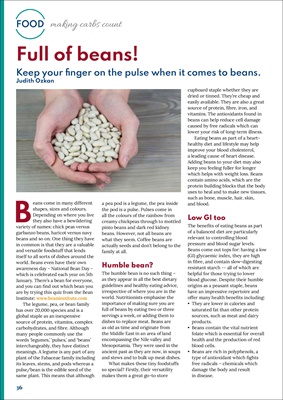
36
FOOD making carbs count
Full of beans!
Keep your finger on the pulse when it comes to beans.
Judith Ozkan
Beans come in many different
shapes, sizes and colours.
Depending on where you live
they also have a bewildering
variety of names: chick peas versus
garbanzo beans, haricot versus navy
beans and so on. One thing they have
in common is that they are a valuable
and versatile foodstuff that lends
itself to all sorts of dishes around the
world. Beans even have their own
awareness day - National Bean Day -
which is celebrated each year on 5th
January. There's a bean for everyone,
and you can find out which bean you
are by trying this quiz from the Bean
Institute: www.beaninstitute.com
The legume, pea, or bean family
has over 20,000 species and is a
global staple as an inexpensive
source of protein, vitamins, complex
carbohydrates, and fibre. Although
many people commonly use the
words 'legumes,' 'pulses,' and 'beans'
interchangeably, they have distinct
meanings. A legume is any part of any
plant of the Fabaceae family including
its leaves, stems, and pods whereas a
pulse/bean is the edible seed of the
same plant. This means that although
a pea pod is a legume, the pea inside
the pod is a pulse. Pulses come in
all the colours of the rainbow from
creamy chickpeas through to mottled
pinto beans and dark red kidney
beans. However, not all beans are
what they seem. Coffee beans are
actually seeds and don't belong to the
family at all.
Humble bean?
The humble bean is no such thing -
as they appear in all the best dietary
guidelines and healthy eating advice,
irrespective of where you are in the
world. Nutritionists emphasise the
importance of making sure you are
full of beans by eating two or three
servings a week, or adding them to
dishes to replace meat. Beans are
as old as time and originate from
the Middle East in an area of land
encompassing the Nile valley and
Mesopotamia. They were used in the
ancient past as they are now, in soups
and stews and to bulk up meat dishes.
What makes these tiny foodstuffs
so special? Firstly, their versatility
makes them a great go-to store
cupboard staple whether they are
dried or tinned. They're cheap and
easily available. They are also a great
source of protein, fibre, iron, and
vitamins. The antioxidants found in
beans can help reduce cell damage
caused by free radicals which can
lower your risk of long-term illness.
Eating beans as part of a hearthealthy
diet and lifestyle may help
improve your blood cholesterol,
a leading cause of heart disease.
Adding beans to your diet may also
keep you feeling fuller for longer
which helps with weight loss. Beans
contain amino acids, which are the
protein building blocks that the body
uses to heal and to make new tissues,
such as bone, muscle, hair, skin,
and blood.
Low GI too
The benefits of eating beans as part
of a balanced diet are particularly
relevant to controlling blood
pressure and blood sugar levels.
Beans come out tops for: having a low
(GI) glycaemic index, they are high
in fibre, and contain slow-digesting
resistant starch -- all of which are
helpful for those trying to lower
blood glucose. Despite their humble
origins as a peasant staple, beans
have an impressive repertoire and
offer many health benefits including:
• They are lower in calories and
saturated fat than other protein
sources, such as meat and dairy
products.
• Beans contain the vital nutrient
folate which is essential for overall
health and the production of red
blood cells.
• Beans are rich in polyphenols, a
type of antioxidant which fights
free radicals - chemicals which
damage the body and result
in disease.